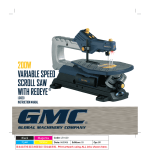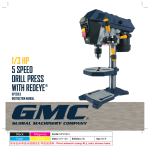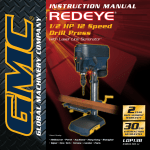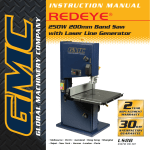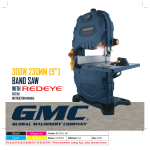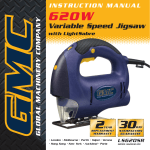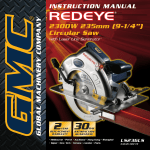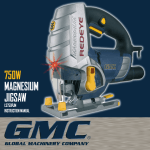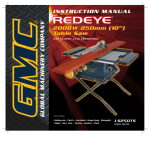Download Global Machinery Company 040521 ED8 PR Saw User Manual
Transcript
INSTRUCTION MANUAL Tile Cutting Saw with Laser Line Generator* • Melbourne • Perth • Auckland • Hong Kong • Shanghai • Taipei • New York • Verona • London • Paris 1 LSTSAW 040521 ED8 PR Contents Introduction Environmental protection Description of symbols Specifications Safety rules for laser lights General safety instructions Additional safety rules for tile cutting saws Position of tile saw Accessories Required tools Unpacking Know your product Attaching the laser light assembly Rip fence Mitre gauge Bevel lock Blade guard Turning on and off Turning on the REDEYE® laser line generator Installing a blade Filling the water compartment Operation Using the REDEYE® laser line generator system Adjusting the REDEYE® laser line generator Changing the batteries Maintenance Cleaning General inspection Repairs Full 2 Years Commercial and Trade Use Warranty 3 3 3 3 4 4 5 6 6 7 7 8 9 9 9 9 10 10 10 10 11 12 13 13 14 14 14 14 14 Whilst every effort is made to ensure your complete satisfaction with this tool, occasionally, due to the mass manufacturing techniques, a tool may not live up to our required level of performance and you may need the assistance of our service department. This product is warranted for a 2-year period for commercial and trade use from the date of the original purchase. If found to be defective in materials or workmanship, the tool or the offending faulty component will be replaced free of charge with another of the same item. A small freight charge may apply. The warranty replacement unit is only made available by returning the tool to the place of purchase with a confirmed register receipt. Proof of purchase is essential. We reserve the right to reject any claim where the purchase cannot be verified. This warranty does not include damage or defects to the tool caused by or resulting from abuse, accidents or alterations. It also does not cover any bonus accessories unless the tool is a GMC Platinum Professional model. Please ensure that you store your receipt in a safe place. Conditions apply to the above warranty. If you need direction of what constitutes a free of charge warranty claim, please review the guide given on the rear of the Receipt Holder. An indication is given as to the types of claim that are permissible, and those that are not. 2 Symbols Dear Customer The rating plate on your tool may show symbols. These represent important information about the product or instructions on its use. Wear hearing protection. Wear eye protection. Wear breathing protection. If you require any help with your product, whether it is a Warranty claim, spare part or user information, please phone our Help Line for an immediate response. Phone 1300 880 001 in Australia or 0800 445 721 in New Zealand. Introduction Conforms to EMC regulations. Your new GMC power tool will more than satisfy your expectations. It has been manufactured under stringent GMC Quality Standards to meet superior performance criteria. You will find your new tool easy and safe to operate, and, with proper care, it will give you many years of dependable service. Caution. Carefully read through this entire Instruction Manual before using your new GMC Power Tool. Take special care to heed the Cautions and Warnings. Your GMC power tool has many features that will make your job faster and easier. Safety, performance, and dependability have been given top priority in the development of this tool, making it easy to maintain and operate. Specifications Nominal voltage: Power: Speed: Blade size: Bore size: Bevel capacity: Maximum Cutting Depth at 90°: Maximum Cutting Depth at 45°: Table Size: Laser class: Laser wavelength: Laser output power: Batteries: Environmental protection Recycle unwanted materials instead of disposing of them as waste. All tools, hoses and packaging should be sorted, taken to the local recycling centre and disposed of in an environmentally safe way. WARNINGS. 1. It may be more difficult to see the laser line in conditions of bright sunshine and on certain surfaces. 2. When storing the tool, remove the batteries in case of leakage. 3. Batteries or damage due to leaking batteries are not covered under warranty. 3 230–240Vac ~ 50Hz 650W 3500min-1 180mm Diamond blade 16mm 0° to 45° 35mm 21mm 420mm x 360mm 2 650nm ≤1mW 2 x AAA Safety rules for laser lights General safety instructions The laser light/laser radiation used in the GMC REDEYE® system is Class 2 with maximum 1mW power and 400700nm wavelengths. These lasers do not normally present an optical hazard, although staring at the beam may cause flash blindness. Warning. Do not stare directly at the laser beam. A hazard may exist if you deliberately stare into the beam, please observe all safety rules as follows; • The laser shall be used and maintained in accordance with the manufacturer’s instructions. • Never aim the beam at any person or an object other than the work piece. To use this tool properly, you must observe the safety regulations, the assembly instructions and the operating instructions to be found in this Manual. All persons who use and service the machine have to be acquainted with this Manual and must be informed about its potential hazards. Children and infirm people must not use this tool. Children should be supervised at all times if they are in the area in which the tool is being used. It is also imperative that you observe the accident prevention regulations in force in your area. The same applies for general rules of occupational health and safety. Warning. When using power tools, basic safety precautions should always be taken to reduce the risk of fire, electric shock and personal injury. Also, please read and heed the advice given in the additional important safety instructions. 1. Keep the work area clean and tidy. Cluttered work areas and benches invite accidents and injury. 2. Consider the environment in which you are working. Do not use power tools in damp or wet locations. Keep the work area well lit. Do not expose power tools to rain. Do not use power tools in the presence of flammable liquids or gases. 3. Keep visitors away from the work area. All visitors and onlookers, especially children and infirm persons, should be kept well away from where you are working. Do not let others in the vicinity make contact with the tool or extension cord. 4. Store tools safely. When not in use, tools should be locked up out of reach. 5. Do not force the tool. The tool will do the job better and safer working at the rate for which it was designed. 6. Use the correct tool for the job. Do not force small tools or attachments to do the job best handled by a heavier duty tool. Never use a tool for a purpose for which it was not intended. LASER LIGHT. LASER RADIATION Do not stare into beam. Only turn laser beam on when tool is on work piece. Class 2 laser product • The laser beam shall not be deliberately aimed at personnel and shall be prevented from being directed towards the eye of a person for longer than 0.25s. • Always ensure the laser beam is aimed at a sturdy work piece without reflective surfaces. i.e. wood or rough coated surfaces are acceptable. Bright shiny reflective sheet steel or the like is not suitable for laser use as the reflective surface could direct the beam back at the operator. • Do not change the laser light assembly with a different type. Repairs must only be carried out by the laser manufacturer or an authorised agent. CAUTION: Use of controls or adjustments or performance of procedures other than those specified herein may result in hazardous radiation exposure. Please refer to the relevant Australian standards, AS 2397 and AS/NZS2211 for more information on Lasers. 4 7. Dress correctly. Do not wear loose clothing or jewellery. They can be caught in moving parts. Rubber gloves and non-slip footwear are recommended when working outdoors. If you have long hair, wear a protective hair covering. 8. Use safety accessories. Safety glasses and earmuffs should always be worn. A face or dust mask is also required if the sanding operation creates dust. 9. Do not abuse the power cord. Never pull the cord to disconnect the tool from the power point. Keep the cord away from heat, oil and sharp edges. 10. Secure the work piece. Use clamps or a vice to hold the work piece. It is safer than using your hand and frees both hands to operate the tool. 11. Do not overreach. Keep your footing secure and balanced at all times. 12. Look after your tools. Keep tools sharp and clean for better and safer performance. Follow the instructions regarding lubrication and accessory changes. Inspect tool cords periodically and, if damaged, have them repaired by an authorised service facility. Inspect extension cords periodically and replace them if damaged. Keep tool handles dry, clean and free from oil and grease. 13. Disconnect idle tools. Switch off the power and disconnect the plug from the power point before servicing, when changing accessories and when the tool is not in use. 14. Remove adjusting keys and wrenches. Check to see that keys and adjusting wrenches are removed from the tool before switching on. 15. Avoid unintentional starting. Always check that the switch is in the OFF position before plugging in the tool to the power supply. Do not carry a plugged in tool with your finger on the switch. 16. Use outdoor rated extension cords. When a tool is used outdoors, use only extension cords that are intended for outdoor use and are so marked. 17. Stay alert. Watch what you are doing. Use common sense. Do not operate a power tool when you are tired. 18. Check for damaged parts. Before using a tool, check that there are no damaged parts. If a part is slightly damaged, carefully determine if it will operate properly and perform its intended function. Check for alignment of moving parts, binding of moving parts, breakage of parts, proper mounting and any other conditions that may affect the operation of the tool. A part that is damaged should be properly repaired or replaced by an authorised service facility, unless otherwise indicated in this Instruction Manual. Defective switches must be replaced by an authorised service facility. Do not use a tool if the switch does not turn the tool on and off correctly. 19. Guard against electric shock. Prevent body contact with grounded objects such as water pipes, radiators, cookers and refrigerator enclosures. 20. Use only approved parts. When servicing, use only identical replacement parts. Use an authorised service facility to fit replacement parts. Additional safety rules for tile cutting saws Always connect the machine to a correctly earthed power supply. SAFETY SWITCH. The use of a 30 mA residual current circuit breaker (RCD) is recommended for extra protection against electric shock. • For your own safety read instruction manual before operating saw • Wear eye protection. • Use top blade guard for every operation for which it can be used. • Disconnect saw before servicing, when changing cutting wheels, and cleaning. • Use tool only with smooth edge cutting wheels free of openings and grooves. 5 Position of tile saw • Replace damaged cutting wheel before operating. • Do not fill water compartment above water fill line. • Ensure that the directional arrow marked on the blade corresponds with the rotational direction of the motor. • With the machine disconnected from the power supply, rotate the blade by hand to ensure it is free from obstruction. • Always keep the blade-securing nut and flanges clean. • Ensure that the blade-securing nut is securely tightened with the wrenches provided. • Never try to cut freehand. Always ensure that the tile to be cut is pressed firmly against the rip fence. • Ensure that the piece of tile that will be cut off has sufficient room to move sideways. Failure to do so may result in the off cut binding against the blade. • Never cut more than one tile at a time. • Never cut pieces too small to be held securely against the rip fence without leaving enough space for the hand to be a safe distance from the blade. • Ensure that the table and surrounding area are clear with the exception of the tile to be cut. • Before cutting a piece of tile let the saw blade run freely for a few seconds. If it makes an unfamiliar sound or vibrates excessively switch it off immediately and disconnect from the power supply. • Let the blade reach full speed before starting the cut. • Let the blade come to a complete stop before removing any jammed or off cut material from around the blade area. • Never allow the blade to run dry. Failure to keep the water compartment topped up will result in possible over-heating of the diamond blade and a poor cut in the tile. Tool Supporting Surface 1. To avoid the possibility of the appliance plug Power Supply Cord or receptacle getting wet, position tile saw to one side of a wall mounted receptacle Drip Loop to prevent water from dripping onto the receptacle or plug. The user should arrange a “drip loop” in the cord connecting the saw to a receptacle. The “drip loop” is that part of the cord below the level of the receptacle, or the connector if an extension cord is used, to prevent water travelling along the cord and coming in contact with the receptacle. 2. If water is present have an electrician complete any necessary work or repairs. DO NOT ATTEMPT ANY REPAIRS YOURSELF. Accessories The GMC LSTSAW tile cutting saw is supplied with the following accessories as standard: • Rip fence • Mitre gauge • Laser light assembly • Laser light arm • Laser light arm locking knob • Face spanners x2 • AAA batteries x2 • 180mm Diamond Blade (Fitted) • Instruction manual • Receipt holder 6 Required tools No tools are required to assemble this tool. 2 face spanners (supplied) are required to change the blade. Unpacking Due to modern mass production techniques, it is unlikely that your GMC Power Tool is faulty or that a part is missing. If you find anything wrong, do not operate the tool until the parts have been replaced or the fault has been rectified. Failure to do so could result in serious personal injury. 1. Remove all loose parts from the carton. 2. Remove the packing materials from around the saw. 3. Carefully lift the saw from the carton and place it on a level work surface. 7 21 22 24 Know your product Before using the saw, familiarize yourself with all the operating features and safety requirements. 1. Housing 2. Carry handle 3. On/off switch 4. Front bevel scale 5. Front bevel lock knob 6. Rear bevel scale 7. Rear bevel lock knob 8. Water compartment 9. Blade cover 10. Blade cover locking knobs 11. Table 12. Table scale 13. Blade guard 14. Blade 15. Rip fence 16. Rip fence locking lever 17. Mitre gauge 18. Mitre gauge locking knob 19. Laser light arm 20. Laser light arm locking knob 21. Laser light assembly 22. Laser light assembly locking knob 23. Laser light assembly battery cover 24. Laser light on/off switch 25. Face spanners 23 19 17 18 15 16 13 12 11 1 9 5 3 8 4 10 25 14 6 20 7 2 8 Attaching the laser light assembly Mitre gauge Take the laser light arm (19) and position it on the left hand side of the saw. Fit the laser light arm locking knob (20) through the arm and into the saw. Tighten the knob to securely fasten the arm onto the saw. The mitre gauge (17) fits over the top of the rip fence and is used to cut tiles at a particular angle. The mitre gauge can be adjusted from 0° to 45° and in conjunction with the fence is used to guide the work piece through the blade. To adjust the angle of the mitre gauge loosen the mitre gauge locking knob (18) at the top of the unit and position the mitre gauge at the desired angle. Fit the laser light assembly (21) onto the end of the arm. Bevel lock The bevel lock is designed to set the table at the desired bevel angle. The tile cutting saw bevel cuts from 0° to 45°. To adjust the bevel angle loosen the front and rear bevel locking knobs (5 & 7). Tilt the table to the desired angle and tighten the bevel locking knobs to secure the table in position. Rip fence Fit the rip fence (15) onto the table (11) on the left hand side of the blade. The rip fence locking lever will need to be loosened in order to fit the fence onto the table. Once the fence is positioned on top of the table push down on the rip fence locking lever (16) to secure the fence in position. If the rip fence is not secured to the table lift up the locking lever and turn it in a clockwise direction to give it a tighter grip. Push down on the locking lever to secure the fence in position. 9 Blade guard vision, enables faster set-up, increases accuracy and improves safety. To turn the laser line on and off press the laser light on/off switch (24). The blade guard (13) provides protection from both sides of the blade. With the power disconnected, adjust the guard so that it’s parallel with and just slightly higher than the thickness of the tile you are going to be cutting. Installing a blade DANGER. • Never try to use a blade larger than the stated capacity of the saw. It will come into contact with the blade guard. • Never use a blade that is too thick to allow the outer blade washer to engage with the flats on the spindle. It will prevent the blade screw from properly securing the blade on the spindle. 1. Adjustments are only to be made with the power off, the tool disconnected from the mains supply and when the blade has fully stopped. 2. Loosen and remove the blade cover locking knobs (10). 3. Remove the blade cover (9). 4. Take the 2 face spanners and use 1 to hold the blade securing nut and the other to hold the flat part of the spindle. Turn the spanner Turning on and off 1. To start the saw insert the switch disabling insert and move the switch (3) up to the ‘ON’ position. 2. Move the switch (3) down to the ‘OFF’ position to turn the saw off. 3. Remove the switch disabling insert to prevent unauthorised use and store it in a secure location out of reach of children. Turning on the REDEYE® laser line generator The REDEYE® laser line generator emits an intense narrow beam of pure red light to guide you as you cut. It improves operator cutting 10 Filling the water compartment holding the blade securing nut in an anti-clockwise direction to loosen the nut. 5. Remove the nut, outer blade flange and blade. 6. Wipe a drop of oil onto the inner blade flange and the outer blade flange where they contact the blade. 7. Fit the new blade onto the spindle taking care that the inner blade flange sits behind the blade. CAUTION. Always install the blade with the arrow printed on the side of the blade pointing down. The direction of blade rotation is also marked on the blade guard and blade cover. 8. Replace the outer blade flange followed by the blade nut. 9. Use the blade spanner to securely tighten the blade bolt. (Tighten in a clockwise direction). 10. Replace the blade cover and secure it with the blade cover locking knobs. CAUTION. Before using the saw after replacing the blade, check that all the safety devices are fitted correctly including the blade guard and that they are all in good working order. Run the saw without loading it to ensure the blade runs true and there are no extraneous noises. 1. The water compartment (8) is incorporated into the main housing 2. The water helps to cool the cutting disc and also limits the amount of dust produced during the cutting process. 3. Fill the water compartment with water. The maximum water level is automatically controlled by the drainage hole on top of the plug, the top of this plug acts as the water fill line. When the water level exceeds the maximum level water will flow out through the hole. 4. Always fill the water compartment to the top of the water fill line to ensure the cutting disc is sufficiently cooled. 11 Operation Making a straight cut Making a mitre cut 1. Adjust the rip fence (15) to the desired width from the blade using the scale (12) on top of the table for reference. 2. Secure the rip fence to the table by lowering the rip fence locking lever (16). 3. Firmly position the tile against the rip fence and pass through the blade in a smooth action. Note. Do not force the tile into the blade too quickly or with excessive force, allow the blade to do the work. 1. Fit the mitre gauge assembly (17) over the rip fence. 2. Choose the desired mitre angle and tighten the mitre gauge locking knob (18). 3. Place the tile into the mitre gauge and hold it firmly in position. 4. Push the mitre gauge together with the tile towards and into the blade. 12 Always ensure the laser beam is aimed at a sturdy work piece without reflective surfaces, i.e. wood or rough coated surfaces are acceptable. Bright shiny reflective sheet steel or the like is not suitable for laser use as the reflective surface could direct the beam back at the operator. Only turn the laser beam on when the work piece is on the tool. 1. Mark the line of the cut on the work piece. Making a bevel cut 2. Adjust the angle of mitre and bevel of the cut as required. 3. Hold the work piece in position using the laser line to align the blade with the mark on the work piece. 4. Plug in the machine and start the motor. 5. Switch on the laser beam using the laser light on/off switch (24). 6. Pass the tile through the blade in a smooth action. 7. Switch off the laser beam on completion of the cut. 1. Loosen the front and rear bevel locking knobs (5 & 7). 2. Tilt the table to the desired bevel angle using the bevel scales (4 & 6) as a guide. 3. Tighten the front and rear bevel locking knobs before making the cut. 4. Firmly position the tile against the rip fence and pass through the blade in a smooth action. When making a bevel cut the rip fence should be positioned on the right hand side of the blade to better support the tile. Adjusting the REDEYE® laser line generator The laser line can be adjusted to line up the laser line with the blade. 1. With the power disconnected place a ruler against the flat part of the blade. 2. Turn on the laser line using the laser light on/off switch (24). 3. If the laser line is not parallel with straight edge adjust the laser line in the following way. 4. Loosen the laser light assembly locking knob (22) and Using the REDEYE® laser line generator system Warnings. Do not stare directly at the laser beam. Never aim the beam at any person or an object other than the work piece. Do not deliberately aim the beam at personnel and ensure that it is not directed towards the eye of a person for longer than 0.25s. 13 Maintenance WARNING. Always ensure that the tool is switched off and the plug is removed from the power point before making and adjustments or maintenance procedures. When you have finished cutting your tiles, always disconnect the power, empty the water and fully clean and dry the machine. Cleaning move the assembly to the left or right until the laser line is in line with the blade. 5. Tighten the laser light assembly locking knob. 1. Keep the tool’s air vents unclogged and clean at all times. 2. Remove dust and dirt regularly. Cleaning is best done with a soft brush or a rag. 3. Re-lubricate all moving parts at regular intervals. 4. Never use caustic agents to clean plastic parts. CAUTION. Do not use cleaning agents to clean the plastic parts of the saw. A mild detergent on a damp cloth is recommended. Changing the batteries 1. Remove the laser light assembly (21) from the laser light arm (19). 2. Slide off the laser light battery cover (23). 3. Replace both AAA batteries, taking care to insert the new batteries with the correct polarity. WARNINGS. Use only correct batteries, 2 x AAA DO NOT mix old and new batteries DO NOT mix alkaline, standard (carbon-zinc) or rechargeable (nickelcadmium) batteries. 4. Replace the laser light battery cover. CAUTION. Remove the laser light batteries when the tool is to be stored without use for a few days or more. If left in position, the batteries might leak and damage the laser light assembly. Damage due to leaking batteries is not covered under warranty. General inspection Regularly check that all the fixing screws are tight. They may vibrate loose over time. Repairs Only an authorised service centre should replace the cordset or effect other repairs. If the cordset is damaged or worn, have it repaired or replaced by an authorised service centre. 14 15 Carefully read the entire Instruction Manual before using this product. Before returning this product for a Warranty Claim or any other reason Please Call 1300 880 001 (Australia) or 0800 445 721 (New Zealand) With continuing product development changes may have occurred which render the product received slightly different to that shown in this instruction manual. The manufacturer reserves the right to change specifications without notice. Note: Specifications may differ from country to country. When you make your call, please have the following information at hand: • GMC Product Type • GMC Product Code A GMC Service Engineer will take your call and, in most cases, will be able to solve your problem over the phone. The GMC 777 Helpline operates from 7am to 7pm, 7 days a week (EST). This allows you to contact GMC directly with any queries and technical questions you have regarding our products. You are welcome to use this phone-in service to make suggestions or give comments about any GMC product. 45–55 South Centre Road Melbourne Airport Victoria, Australia 3045 Tel: (03) 8346 1100 Fax: (03) 8346 1200 Save this Manual for future reference. 16

















